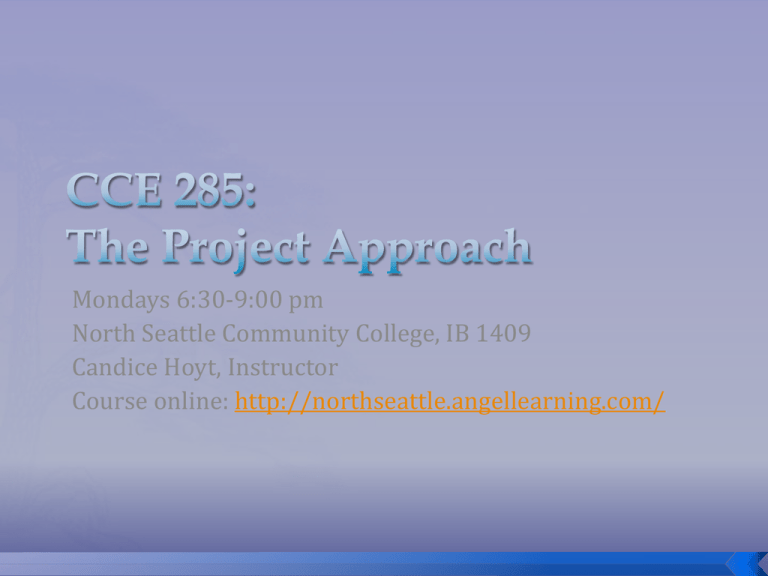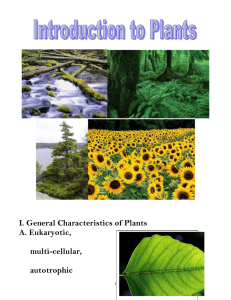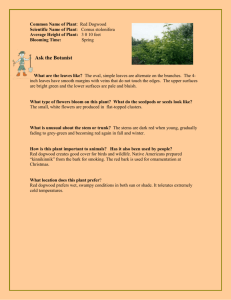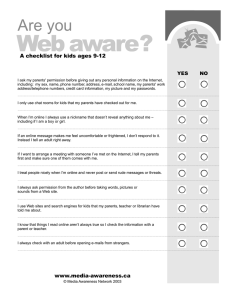Mondays 6:30-9:00 pm North Seattle Community College, IB 1409 Candice Hoyt, Instructor :
advertisement

Mondays 6:30-9:00 pm North Seattle Community College, IB 1409 Candice Hoyt, Instructor Course online: http://northseattle.angellearning.com/ Phases I, II & III overview Reggio video examples Amusement Park for the Birds Silent Movies Assembly & democracy Your wetlands projects Report assembly style Monday: Bring & present documentation for Phases I-II Following Monday: Complete through Phase III Phase 1 (a): Teachers What are the children interested in? Teachers’ webs Anticipatory knowledge web Anticipatory questions web Anticipatory Planning Web = topics derived from questions + curriculum opportunities Explore resources & field sites Provide focusing activities & common experiences Based on resources & field sites Decide if topic is appropriate and practical Based on activities done Phase 1 (b): Teachers & Children together Children’s webs (teacher documents only, no questions, answers or additions) Knowledge web – current concepts and understanding (What do the children know?) Question web/list (What do they want to find out?) Move to Phase II to investigate questions listed Practical Considerations in Topic Selection (Young Investigators, pp. 14-15) Types of documentation (Windows on Learning, p. 21) Narratives Letter to parents Teachers web Meeting time between adults runs along-side these actions Teachers’ journals Products Children represent Children’s webs Draw Record words & conversations between kids Feed kids/busy them to keep them talking - “coffee cloche” “If anyone wants to make ____ out of playdough, I have the playdough here.” Child self-reflections Record their conversations/ themselves & play it back Kids bring in artifacts/representation Figure 3.1 (p. 21) for more Children’s web Listen & write down What they KNOW What they WONDER Do NOT correct Do NOT answer Write it and support that they are talking about “it” Can say, “I want to write down what we all wonder about.” Play “ignorant” on kids’ level Essentials of Projects “We are learning together” Emergent Curriculum Test root interest Treasure spontaneous shifts in direction Skill development opportunities Numeracy Literacy Exploring with new media Clay Sugar cubes & colored glue Shift from: Asking kids to do something at our request Begin Phase II (Young Investigators, p. 28) Note [P] = Parent Involvement Opportunity Teacher Re-examine anticipatory planning web Revise to actual “planning web” Teacher & children Prepare for field work & expert visitors [P] Phase II continued (Young Investigators, p. 38) Investigate (YI, p. 10) Visit field sites Talk to visitors & other experts [& read about?] Examine artifacts Conduct experiments Teacher: document children’s experiences Photos Video Transcriptions of discussions Represent what was learned (as it is learned) Writing & drawing Writing/sketching on-site Counting/measuring Construction Dancing & dramatic play Teacher: document children’s experiences as in “Investigate” Revisit web or re-web What was learned Identify new questions Repeat Investigation Representation Re-web Teacher journal (private) Teacher & children: Webs and re-webs Teacher: document children’s experiences & representations Children working: Photos Video Transcriptions of discussions Children’s work: Construction Dancing & dramatic play Visitors Field trips Children: represent Writing & drawing Writing/sketching on-site Counting/measuring Construction Dancing & dramatic play “The Contribution of Documentation to the Quality of Early Childhood Education” by Lilian G. Katz and Sylvia C. Chard (1996) – optional Children begin to run out of questions Project discussions fail to inspire much interest or participation Class & teacher lose interest in the topic Children choose project activities & examine project documentation less frequently Phase III (Young Investigators, p. 52) Teacher & students prepare: Debrief Plan culminating event for students to share the narrative & products of the project Create narratives (see YI p. 21) Teacher & students complete: Do culminating event or activities Do activity Display/finalize narratives Present to outside audiences Teacher: Review project & assess achievement of goals Thinking Big West Seattle people are going to meet up to watch together Amusement Park for the Birds Silent Movies Direct questions / tutorials The teacher pushed Simone to tell her what he thought made the fountain run Isn’t this against D3 (etc)? Cultural – USA: Children expected to have the right answer Reggio: Children invited into a conversation Can create a culture in your own environment Children want to sit and have a conversation – with a followup question When do kids start writing (on their drawings, etc)? When they want to - ask you to write something so they can transfer it Mixed-age groups work great How to get a kid to start a web (never did one before)? Show example: When I wanted to learn more about slimy water, first I made a web about what I knew, and then one about what I wanted to know. Explain usefulness: I used the “what I know” to come up with the questions, then I used the questions to plan what to do to find out answers to my questions. My kids are too young to do a web. Do the teacher’s anticipatory webs, then do the focusing activities (trying out the idea) and watch for non-verbal cues about their knowledge about and interest in particular items and their questioning When I started asking why he liked it he closed up and now doesn’t like cars anymore! How do I keep a kid interested? Kids in groups talk to each other – feed off of each other. What if only 1 child in the group (or pair) is interested? Focusing activities, etc, can help – do the field trip or read the books all together; maybe the other child will get interested. Democratic Community “Push it back” to the people Ex: If teacher is concerned about too much noise, record noise & play it for kids so they can talk about it. “Facilitating Civil Discourse in the Classroom” (Ashton, 2006) (PDF) (Word) Socially-constructed reality in projects determine what we do. Decide what is… Right Necessary Worthwhile Possible To determine sociallyconstructed reality… Voting: majority rules Compromise: someone gives something up Consensus: confirmed by silence GOAL: Search for wisdom: through disagreement & continuous revision Teacher roles Document children’s ideas and questions Do not answer questions Paraphrase to return them “So you are wondering if…” Do not ASK questions Can talk from “I…” to model how children should talk I wonder… I know that… Facilitate the tempo & energy of the meeting End meeting if too wild (with promise to continue later) Have children split into smaller groups each with a teacher concurrently or consecutively Break children into individuals and do a roaming assist of children documenting their own questions and knowledge before returning to a larger group to collect and document PHASE ONE Your webs What we know What we want to know Curriculum additions PHASE TWO Your investigation activities Your discoveries Your new questions Pretending each of us is a small group of children Questions: Meaning of a lilac Curriculum Senses Pollination, photosynthesis Seasons Comparisons Scents Library research Difficult/expensive to get lilac extract Artificial Could crush flowers with hands but didn’t smell on hand Where they’re from Caterpillars lay eggs on lilacs & eat when they hatch New questions How many lilacs in my neighborhood map Colors, scents, etc Bring in variety of lilacs Memories connected to scents Symbiosis Want to know Safe to drink? There all the time? Seasonal? Who lives there? How deep? Curriculum Geography/maps Graphs on depth – math Biology, science (safe?) Literacy Doing songs, etc Investigations Revisit pond Water samples Microscope – very alive! Video Maps Wild life Branch into water Finding songs, etc New question Are there fish there? Representation Play dough model of pond Drawings of the algae What we know Neighborhood named Doesn’t grow straight Grows taller than other trees around Sheds bark Flowers Grows in NW climate Want to know Why bark sheds Depth of roots Weather (moist?) Commercial products produced Looks like in other seasons Length to grow to max height Other names (Latin) Animal life / animal shelter Curriculum additions Math Counting days of flowers/ bark Blooms on branches Science Try to grow our own Examine shedding under microscope Arborist to talk Investigations Revisit & looking online Flowers smell Flowers: in clusters, variety of foliage around trunk Bark peels to show golden bronze, very smooth Edible berries – limited amt for humans Called “The Madrone” – specific to West Coast New questions Why does the trunk bend? Following sun? How long bark shed? Berries & flowers grow together Seasonal? Cycle/direction of Flowers? Leaves? Berries? Considered Evergreen We didn’t know much when we started Build dams Mammals Probably not any in Seattle Questions Everything else Curriculum Literacy Math – building Geography, mapping distance Try to build a sufficient dam Investigations Researching Beavers chew on bark not eat them like Nutrias European vs. N. American Mate for life Alter environment as much as humans (or… more than other animals) Revisiting It’s a pile of sticks Q: What’s the difference? Visiting actual beaver dam Ask ranger what is in the pond? Example of project with documentation: “The Movie Theater Project” Windows on Learning pp. 85-109 Optional to read this by 4/26 for assistance with your project’s documents preparation for Monday. Required to read this by 5/3 (added) “Multiple Symbolization in the Long Jump Project” (Forman) (PDF) – optional Reggio Look through the books in pairs or 3’s Look around online yourself In class (team) 4/26 – Present Phases I & II of wetlands projects Bring ALL documentation, including drawings & photos Submissions 4/25 – Interval Paper A7b(3) 4/26 – Read: pp. 51-97 5/2 – Interval Paper A7b(4) 5/3 – In-class: Completed bound book Readings 4/26 Required: “Facilitating Civil Discourse in the Classroom” Optional (5/3 required): Windows on Learning, pp. 85-109 Optional: “Multiple Symbolization in the Long Jump Project”


